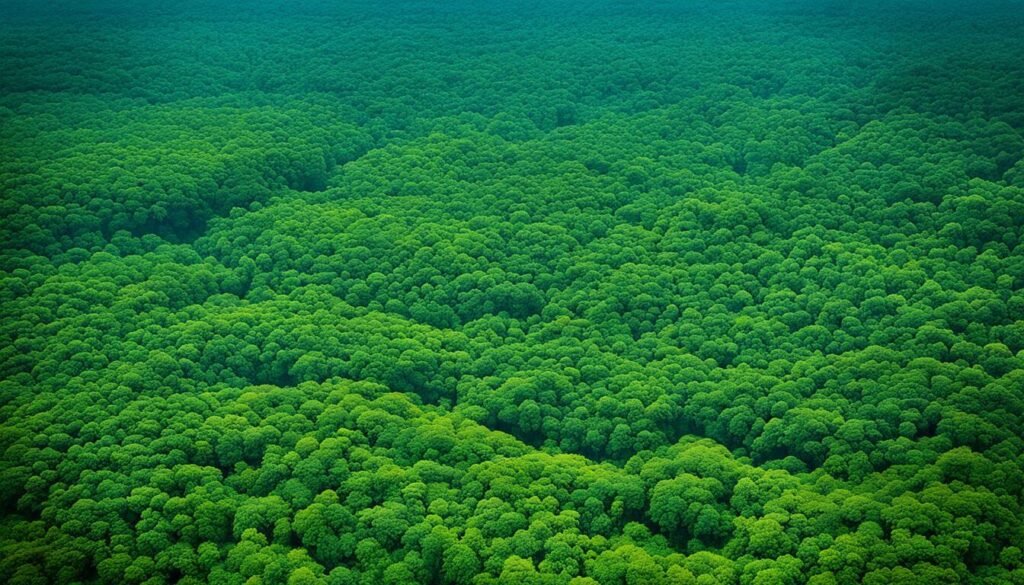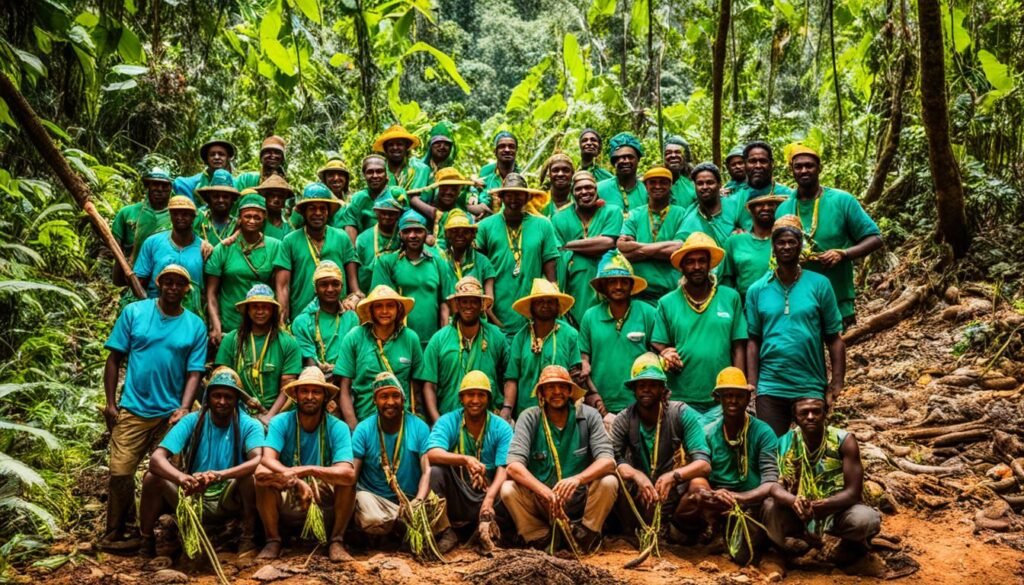Did you know that the Central African Republic (CAR) is home to over 220,000 square kilometers of rainforests, making it one of the most significant forest strongholds in the Sahel region? This vast and ecologically vital ecosystem stretches from the capital city of Bangui to the remote Vakaga Province, providing critical habitats for an incredible diversity of plant and animal life. However, the rainforests of the Central African Republic face a multitude of threats, from deforestation and urban expansion to the devastating impacts of political instability and armed conflicts.
This article will delve into the geographical significance of CAR’s rainforests, the challenges they face, and the ongoing efforts to conserve these precious natural resources. We will explore the role of international partnerships, the importance of the Dzanga-Sangha Protected Areas, and the vital contributions of indigenous communities in safeguarding the country’s biodiversity. Additionally, we will discuss the potential of ecotourism and sustainable development initiatives to support conservation efforts while empowering local communities.
Key Takeaways
- The Central African Republic is home to one of the largest rainforest areas in the Sahel region, covering over 220,000 square kilometers.
- The rainforests of Bangui and the broader CAR are facing various threats, including deforestation, urban expansion, and the impacts of political instability and armed conflicts.
- International partnerships, such as the CAFI initiative, are working to support the Central African Republic’s efforts to recover and implement sustainable forest management strategies.
- The Dzanga-Sangha Protected Areas are a crucial conservation hub, preserving the region’s unique biodiversity and supporting the livelihoods of indigenous communities.
- Ecotourism and sustainable development initiatives have the potential to contribute to the protection of CAR’s rainforests while providing economic opportunities for local communities.
Introduction to the Central African Republic’s Rainforests
The Central African Republic is situated in the heart of the Congo Basin, home to the world’s second-largest rainforest after the Amazon. The country’s lush rainforests are divided into two major massifs: one in the southwest and the Bangassou forest in the east. These forests are an integral part of the Congo Basin, a global biodiversity hotspot renowned for its exceptional plant and animal diversity.
Geographical Location and Ecological Significance
The Central African Republic’s rainforests stretch across a vast expanse, covering a significant portion of the country’s geography. These forests are closely linked to the Congo Basin, which spans several Central African nations, including the Democratic Republic of the Congo, Republic of the Congo, and Gabon. The country’s rainforests play a crucial role in the region’s ecological balance, serving as a vital carbon sink and regulating local climates.
Biodiversity Hotspots and Unique Species
The Central African Republic’s rainforests are home to an incredibly diverse array of plant and animal species, many of which are endangered or vulnerable. The country is part of the Sahel region, a transitional zone between the Sahara Desert and the lush Congo Basin. This unique geographic position contributes to the rainforests’ exceptional biodiversity, with a wide range of endemic and threatened species, such as the critically endangered western lowland gorilla and the vulnerable forest elephant.
Threats to the Rainforests of Bangui
The rainforests of the Central African Republic, particularly those surrounding the capital city of Bangui, face a range of threats that jeopardize their long-term survival. Deforestation and forest degradation are significant challenges, driven by a variety of factors such as illegal logging, land conversion for agriculture, and the growing demand for fuel wood to meet the energy needs of the country’s expanding urban population.
Deforestation and Forest Degradation
The rapid deforestation and degradation of the Central African Republic’s rainforests are fueled by a range of activities, including illegal logging operations and the clearing of land for subsistence farming and commercial agriculture. These practices not only reduce the overall forest cover but also fragment the remaining habitats, posing a serious threat to the region’s rich biodiversity.
Urban Expansion and Fuel Wood Demand
The growth of urban centers like Bangui is putting increasing pressure on the surrounding rainforests. As the population expands, the demand for land and resources to support development, housing, and the need for fuel wood as a primary energy source is contributing to the loss and fragmentation of these vital ecosystems. The unsustainable collection of fuel wood for cooking and heating is a significant driver of forest degradation in the Central African Republic.

The Role of the CAFI Partnership
In response to the pressing challenges facing the Central African Republic’s (CAR) rainforests, the international community has stepped up its efforts to support the country’s recovery and sustainable development. The Central African Forest Initiative (CAFI) has emerged as a key player, partnering with the CAR government to tackle deforestation and promote low-carbon growth.
Supporting Central African Republic’s Recovery
CAFI has provided vital funding and technical assistance to help the CAR government develop a comprehensive National Investment Framework for REDD+. This framework outlines a strategic approach to addressing the root causes of deforestation and forest degradation, while also driving sustainable development initiatives across the country.
National Investment Framework for REDD+
The National Investment Framework for REDD+ in the Central African Republic is a crucial component of the CAFI partnership. It serves as a roadmap for implementing operational investments that can be replicated across the country as the reconciliation process advances. The framework aims to strengthen central and local government institutions, empower local communities, and drive sustainable land-use practices that balance economic growth and environmental protection.
Through this collaborative partnership, CAFI and the CAR government are working to unlock the potential of the country’s rainforests, not only for their vital ecological role but also as a foundation for sustainable development and economic prosperity for all Bangui residents.
The Dzanga-Sangha Protected Areas
Nestled within the lush rainforests of the Central African Republic, the Dzanga-Sangha Protected Areas (DSPA) stand as a shining example of conservation efforts in the Congo Basin. This UNESCO World Heritage Site is renowned for its exceptional biodiversity, serving as a haven for endangered species like forest elephants and western lowland gorillas.
Significance of the Dzanga-Sangha Reserve
The Dzanga-Sangha Reserve, a core component of the DSPA, is part of the larger Tri-National Sangha landscape, which extends across the borders of Cameroon and the Republic of Congo. This interconnected system of protected areas forms a vital part of the Congo Basin ecosystem, one of the most biodiverse regions in the world. The DSPA’s unique habitats, including dense forests, savannas, and swamps, support a rich tapestry of flora and fauna that is essential to the ecological balance of the region.

The Dzanga-Sangha Reserve is home to a diverse array of species, including the iconic forest elephant and the elusive western lowland gorilla. These charismatic species, along with countless other rare and endemic plants and animals, contribute to the area’s exceptional biodiversity, making it a true gem within the Central African Republic’s natural heritage.
Indigenous Communities and Conservation Efforts
The Central African Republic’s rainforests are not only vital for their ecological significance but also for the indigenous communities that have long relied on them for their livelihoods. The Ba’Aka pygmy tribe, for instance, share a deep connection with the Dzanga-Sangha Reserve and engage in sustainable practices such as low-impact agriculture and the collection of non-timber forest products.
Conservation efforts in the region aim to promote the rights and well-being of these indigenous groups, ensuring that they are actively involved in the management and protection of the rainforests they call home. By collaborating with the Ba’Aka and other local communities, conservation initiatives in the Central African Republic strive to balance sustainable development and community engagement, safeguarding the delicate balance of the rainforest ecosystem.
These efforts not only preserve the ecological integrity of the Central African Republic’s rainforests but also empower the indigenous communities who have been the stewards of these vital natural resources for generations. The integration of local knowledge and traditional practices into conservation strategies is crucial for the long-term sustainability of the region’s biodiversity and the livelihoods of its inhabitants.
Ecotourism and Sustainable Development
In the Central African Republic, ecotourism has emerged as a vital component of sustainable development efforts, particularly in the Dzanga-Sangha Protected Areas. The World Wildlife Fund (WWF) and other partners work tirelessly to promote responsible tourism that generates revenue for conservation initiatives and provides economic opportunities for local communities.
Promoting Responsible Tourism
The focus is on developing ecotourism that minimizes the environmental impact while maximizing the benefits for the local populations. This includes initiatives to involve indigenous groups like the Ba’Aka in ecotourism activities, ensuring that the economic and social rewards are equitably shared and that they are empowered as stewards of the rainforest.
Community Involvement and Benefit Sharing
By engaging the local communities in the Dzanga-Sangha region, the ecotourism efforts aim to support their livelihoods and strengthen their role as custodians of the Central African Republic’s precious rainforests. This collaborative approach to sustainable development fosters a sense of ownership and commitment, ultimately contributing to the long-term preservation of this biodiversity hotspot.
Central African Republic’s Conservation Challenges
The Central African Republic has faced formidable obstacles in its efforts to conserve its precious rainforests. The country’s long history of political instability and armed conflicts have significantly hindered its conservation efforts. The complex geopolitical dynamics of the Françafrique region, the presence of armed groups like the Lord’s Resistance Army, and the exploitation of conflict minerals have all undermined the government’s ability to effectively manage and protect its natural resources.
Political turmoil and security threats have been a constant challenge for the Central African Republic. Recurring cycles of violence, coups, and civil unrest have destabilized the country, making it difficult for the government to focus on conservation initiatives. The presence of armed groups, such as the notorious Lord’s Resistance Army, has also posed a grave threat, as they engage in poaching and the illicit trade of wildlife and natural resources to fund their activities.
Furthermore, the regional dynamics of the Françafrique, a term used to describe the complex web of political and economic relationships between France and its former African colonies, have complicated the Central African Republic’s conservation efforts. The exploitation of conflict minerals, such as those found in the country’s forests, has fueled ongoing conflicts and undermined sustainable development efforts.
These security threats and governance issues have significantly hindered the Central African Republic’s ability to protect its rainforests and biodiversity. Overcoming these complex challenges will require a multifaceted approach, involving international cooperation, strengthening of institutions, and a commitment to sustainable development that prioritizes both conservation and the well-being of local communities.
Anti-Poaching and Wildlife Protection
The Central African Republic’s rainforests face a multitude of threats, including the scourge of poaching and the illegal wildlife trade. These illicit activities endanger the region’s iconic species, such as the forest elephants and western lowland gorillas found in the Dzanga-Sangha Protected Areas.
In response, the World Wildlife Fund (WWF) and the International Union for Conservation of Nature (IUCN) have spearheaded anti-poaching efforts to safeguard the Central African Republic’s biodiversity. These initiatives aim to strengthen law enforcement, reduce the demand for illegal wildlife products, and empower local communities to become active guardians of the rainforest’s endangered fauna.
Combating Illegal Wildlife Trade
At the heart of these conservation efforts is the fight against the illegal wildlife trade, a global scourge that threatens the very existence of many species. By working closely with government authorities, civil society, and international partners, the anti-poaching programs in the Central African Republic strive to disrupt the supply chains and tackle the underlying drivers of this illicit activity.
Through enhanced patrols, targeted intelligence-gathering, and community engagement, the teams on the ground are making strides in protecting the Central African Republic’s wildlife. The Dzanga-Sangha Protected Areas, in particular, have seen a decline in poaching incidents, thanks to these collaborative efforts to safeguard the region’s natural heritage.

Collaborative Partnerships and International Support
Addressing the multifaceted challenges facing the Central African Republic’s rainforests requires a collaborative approach that leverages the expertise and resources of various stakeholders. The Central African Forest Initiative (CAFI), for instance, brings together the government, international donors, and civil society organizations to support the country’s sustainable development efforts. Through this partnership, the Central African Republic is able to access critical funding and technical assistance for its REDD+ program, which aims to reduce deforestation and forest degradation.
In addition to CAFI, the European Union’s ECOFAC program has also played a significant role in supporting conservation initiatives in the Central African Republic. ECOFAC has funded projects in the Dzanga-Sangha Protected Areas, which help to improve the living conditions of indigenous communities while conserving the region’s precious biodiversity. These types of international partnerships and cross-sectoral collaborations are crucial for the long-term protection and management of the Central African Republic’s rainforest ecosystems.
The World Wildlife Fund (WWF) has also been actively involved in the Central African Republic, working alongside the government and local communities to implement sustainable forest management practices. Through these collaborative efforts, the Central African Republic is able to leverage a diverse range of expertise and resources to address the complex challenges facing its rainforests.
As the Central African Republic continues to navigate the challenges of political instability and armed conflicts, the support of the international community will be crucial for the future of its rainforests. By fostering strong partnerships and securing sustained funding, the country can strengthen its capacity to protect this invaluable natural resource and secure a more sustainable future for its people and the planet.
Preserving Indigenous Knowledge and Rights
The Central African Republic’s rainforests are not only crucial for their ecological significance, but also for the cultural and traditional knowledge of the indigenous communities who have inhabited these landscapes for generations. Groups like the Ba’Aka pygmies possess a deep understanding of the forest’s resources and sustainable practices, which can inform and guide conservation efforts in the region.
Preserving the rights and traditional knowledge of these indigenous communities is essential for ensuring the long-term protection and sustainable use of the Central African Republic’s rainforests. By supporting the livelihoods and cultural identity of these groups, we can also promote sustainable development and strengthen the resilience of the entire ecosystem.

The Ba’Aka and other indigenous communities in the Central African Republic have developed intricate and sustainable methods of interacting with the rainforest, from hunting and gathering to traditional land management practices. This indigenous knowledge, accumulated over centuries, can provide invaluable insights for conservation efforts that aim to balance human needs with ecological preservation.
Recognizing and protecting the rights of these indigenous groups, including their access to ancestral lands and resources, is crucial for empowering them as partners in sustainable development. By incorporating their knowledge and perspectives, policymakers and conservation organizations can ensure that the needs and aspirations of local communities are fully integrated into rainforest management strategies in the Central African Republic.
Future Prospects and Sustainable Strategies
As the Central African Republic looks to the future, it faces the complex challenge of balancing its economic and social development needs with the imperative to protect its vital rainforest ecosystems. The National Investment Framework for REDD+, developed with the support of the CAFI partnership, outlines a strategic approach to address deforestation and forest degradation while promoting low-carbon, resilient growth.
Achieving this balance will require continued collaboration between the Central African Republic’s government, local communities, and international partners. By implementing sustainable land use practices, strengthening governance, and investing in the long-term preservation of the country’s rainforests and the biodiversity they support, the nation can chart a path towards a more sustainable future.
Balancing Development and Conservation
The Central African Republic’s rich natural resources, including its vast rainforest expanse, offer immense potential for sustainable development. REDD+ initiatives, focused on reducing emissions from deforestation and forest degradation, hold promise in aligning economic growth with environmental conservation. Careful planning and investment in low-carbon industries, ecotourism, and community-based natural resource management can help the country unlock its development potential while safeguarding its precious rainforests for generations to come.
Conclusion
The rainforests of the Central African Republic, situated around the capital city of Bangui, represent a critical global resource that faces various threats. Despite the challenges of political instability, armed conflicts, and resource exploitation, the country has made commendable efforts to conserve these precious ecosystems through collaborative partnerships, sustainable development initiatives, and the protection of indigenous communities.
As the Central African Republic looks towards the future, it will be crucial to build upon these efforts, striking a balance between development needs and conservation goals. By ensuring the long-term preservation of its rainforests and the biodiversity they harbor, the country can serve as a model for rainforest conservation in the Congo Basin and beyond.
With continued international support and a steadfast commitment to sustainable strategies, the Central African Republic can secure the future of its rainforests, which are not only an invaluable ecological resource but also a vital part of the cultural heritage and livelihoods of its indigenous communities. The path forward demands a comprehensive approach that addresses the complex challenges facing the region, while capitalizing on the opportunities for sustainable development and environmental preservation.
Source Links
- Central African Republic: conserving nature and beating the virus together – https://international-partnerships.ec.europa.eu/news-and-events/stories/central-african-republic-conserving-nature-and-beating-virus-together_en
- Central African Republic | Central African Forest Initiative (CAFI) – https://www.cafi.org/countries/central-african-republic
- WWF in the Central African Republic – https://origin-congo.wwf-sites.org/where_we_work/central_africa_republic/


